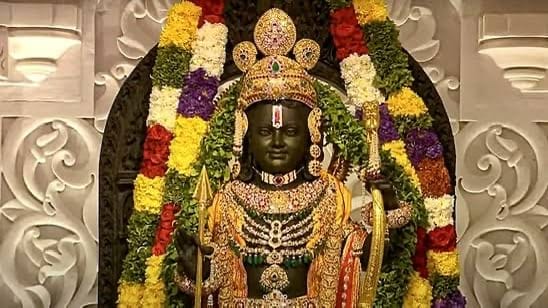Ram is in our Culture

What was it that strung together the erudite and the unlettered, the celebrities and the paupers, the saffron-clad and the designer-clad, those that flew in and those who trudged in? The name of Ram acted as an invisible thread to string together a sea of humanity … nay, a sea of devotion! Finally, we have a face to the name that has been a part of our culture since the Treta Yug. In an era where there were no airplanes, trains, phones, WhatsApp, email, photographs etc. Ram certainly had some charisma that he is remembered with such fondness and devotion after thousands of years.
The making of the Ram Mandir in Ayodhya has set in stone the eternal truth. Bhagwan Ram was born in Ayodhya and walked the Earth in human form. He is not a mythological character. He is a part of our history. The Mandir is a testament to the faith of all who believe themselves to be lucky to have been born in this country!
Our parents would invoke, ‘Ram’ on many occasions. In greeting they said, ‘Ram Ram!’, in grief, ‘He Ram’, in embarrassment, ‘Haye Ram’, in hopelessness, ‘Ram Bharose’, in certainty, ‘Ram baan’, in death, ‘Ram naam satya hai!’
The live telecast of the Pranpratishtha showed a plethora of people in the crowds at Ayodhya. Bollywood was there in large numbers. I also felt that most of the politicians in responsible positions, did not go to Ayodhya and rather oversaw the celebrations in their states. People danced, distributed mithai, laughed, celebrated, and even wept together in bliss.
Bhagwan Ram traversed through Bharat and visited Prayagraj, the place of confluence of the rivers Ganga, Yamuna and Saraswati; Panchvati where Sitaji was abducted by Ravan; LePakshi where Jatayu was struck down by Ravan; Kishkindha where Bhagwan Ram met Hanumanji, befriended Sugriva and killed Bali; Rameshwaram where he did Shivling sthapana and started building the Ram-setu up to Lanka, etc.
We are a people passionate about our beliefs. Prayers and rituals are an important part of our culture. Years of prayers led to the making of the Ram Mandir and Pranpratishtha of the idol of Balak Ram. Pranpratishtha is a ceremony where the divine is invited to enter the idol and reside therein. We believe that every atom of the universe has divinity in it. In humans it is in the waking stage. In nonliving things, it is in the sleeping stage. So, the divinity latent in the stone idol was invoked to become potent and come alive! Just like by taking oath as the Prime Minister or Governor, an ordinary human becomes a person of great status and commands respect, the prayers and adulations of millions of devotees participating in the Pranpratishtha inviting divinity to come alive in that idol, make the idol become worthy of worship!
Are just prayers, mantras and rituals enough? Hanumanji had reported that Lanka was echoing with recitation of Vedas and the air was thick with sacrificial smoke. But the rakshasas were wicked, despite all that ritual worship. Ravan sought to gain Prakriti (the manifestation), not Purusha (the creator). He wanted just Sita, not Ram! His lust caused his end. His ten heads indicated his mastery over the four Vedas and the six Shastras. But of what avail was all that learning? He ruined his entire clan. His sons, brother and kinsmen were killed. His country was reduced to ashes. Before Ravan died, he exclaimed, ‘Oh men! Don’t live as I have lived and ruin your lives.’
I am reminded of the bhajan, ‘Ram naam ki loot hai, loot sake to loot. Antkaal pachtaayega jab praan jaayenge choot!’ Soaking in the bliss of Ram-naam let’s make our hearts like Ayodhya, so that the Atma-Ram within, shines forth in all brilliance! Let’s savour this time that shall be a bookmarked in the annals of our history!
This piece is published in the Hindustan Times on 28.01.2023. It can be viewed here https://www.hindustantimes.com/cities/chandigarh-news/sunrays-ram-is-in-our-culture-101706416224672.html
Would you like to share your thoughts in the comments section below? I would be happy to know what you feel!
